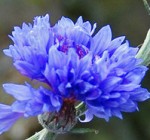 The plant known as bachelor’s button today is Centaurea cyanus, an annual native to Europe. It is in the aster family, Asteraceae that also includes daisies, sunflowers, and lettuce. Intense blue flowerheads are carried in spring and early summer on branched stems with gray-green leaves. It is unlikely that Shakespeare had this plant or any particular plant in mind when he wrote and more probably meant any flower in bud.
The plant known as bachelor’s button today is Centaurea cyanus, an annual native to Europe. It is in the aster family, Asteraceae that also includes daisies, sunflowers, and lettuce. Intense blue flowerheads are carried in spring and early summer on branched stems with gray-green leaves. It is unlikely that Shakespeare had this plant or any particular plant in mind when he wrote and more probably meant any flower in bud.
Shakespeare alludes to bachelor’s button in only two plays:
In The Merry Wives of Windsor, act iii, sc. 2 (67) The host ask:
What say you to young
Master Fenton? he capers, he
dances, he has eyes of youth, he
writes verses, he speaks holiday,
he smells April and May; he will
carry’t, he will carr’t; ‘tis in his
Buttons; he will carry’t.
In Hamlet, act I, sc. 3 (54), Laertes addresses Ophelia, warning her about her involvement with hamlet:
The canker galls the infants of the Spring
Too oft before their Buttons be disclosed.